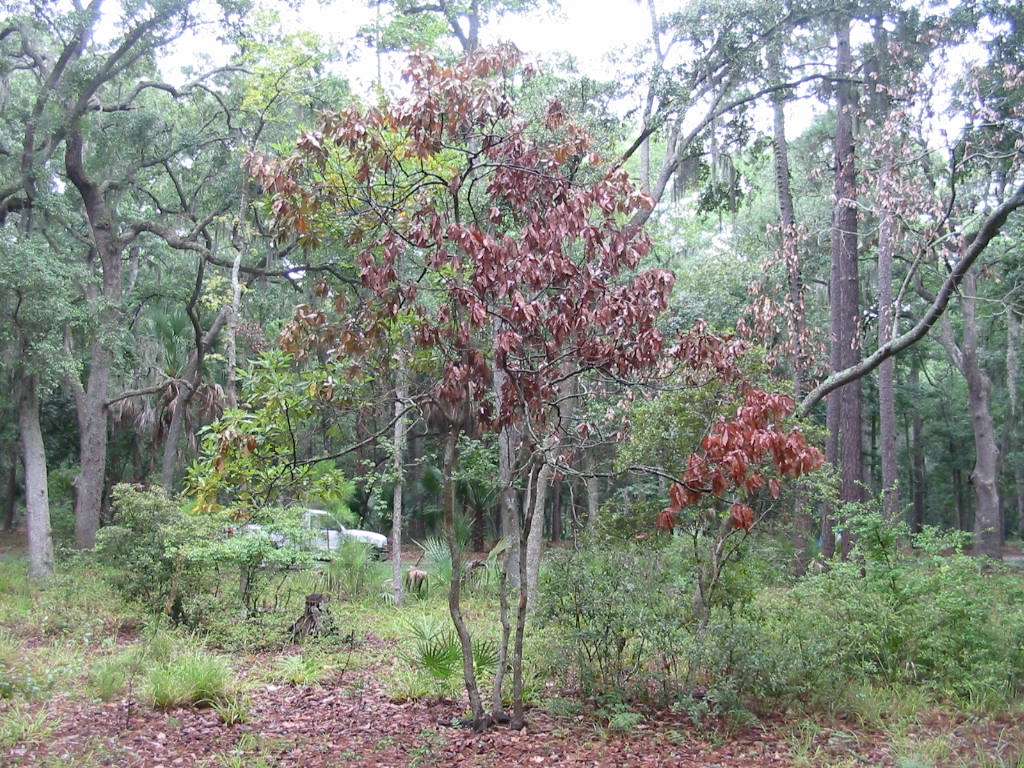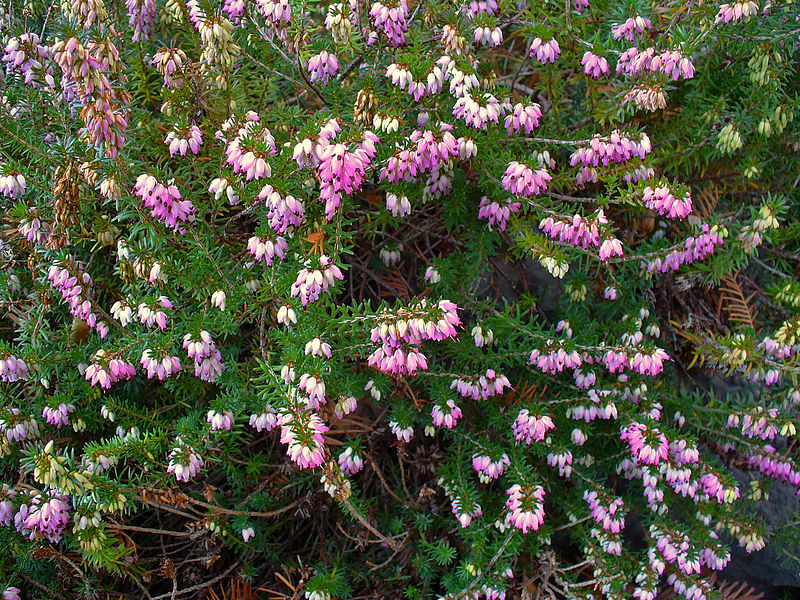
A British scientist has proposed a new way to conduct early pest detection surveillance that she thinks will better serve resource managers: prioritize ecosystems which would suffer the greatest alteration if a non-native plant pest decimated one or more plant species. She says scientists should focus on foundational species and maintaining habitat resilience.
Dr. Ruth J. Mitchell leads the Biodiversity and Ecosystems Group within the Ecological Sciences Department at the James Hutton Institute in Aberdeen, Scotland. The Institute works on issues relevant to sustainable management of natural resources. I provide a full citation of her article at the end of the blog.
Dr. Mitchell’s focus is on protecting biological diversity. She worries that introduced plant pests can drive large-scale declines in native plant species. She mentions several examples, including chestnut blight and ash decline. Those declines, in turn, can cause a range of cascading effects on associated species that use the host plant for feeding, breeding and shelter, and on ecosystem functioning. To be prepared to counter this level of risk, managers of natural habitats need to know which habitats and plants are at greatest risk in order to prioritize surveillance of the most likely human actions and sites; and allocate resources to address the most damaging invasions.
Her proposal: prioritize host plant species or habitats which ecological theory indicates an invasion would have the greatest ecological impact. In other words, focus on “foundational species” — plant species that drive key ecosystem functions; or low (plant) diversity habitats — based on the assumption that diverse communities are more stable and resilient than less diverse communities.
Mitchell notes that ecological theory posits that if a foundation species is lost or declines, its disappearance will have a greater effect on the ecosystem than if non-foundation species are impacted. She believes that although there is no list of foundation species, scientific staff can develop appropriate lists for their site. For her study, she made the simplistic assumption that those species that occur at high abundance are most likely to be foundation species. Regarding the second, habitat-resilience criterion, Mitchell assumed that a pest which eliminates a plant species in a low-diversity habitat is likely to have a greater ecological impact on that habitat’s functioning than would extinction of a species in a high-diversity habitat, which is likely to have redundancies.
Mitchell asserts that these approaches to surveillance take account of an invasion’s impacts on broader associated species and ecosystem functions – on biodiversity broadly. These suggested methods have other advantages, too. They avoid the bias in existing lists of pests, which consist predominantly plants of commercial importance; and they don’t need to be updated frequently.
Mitchell identifies four ways to prioritize surveillance efforts based on the potential host rather than the potential pest. The surveillance monitoring might target:
(1) Plant genera known to host the pests (including pathogens) most likely to establish (Host-pest);
(2) Habitats harboring hosts for the greatest number of pests most likely to establish (Habitat-pest);
(3) Plants classed as foundation species (Foundation-species);
(4) Habitats with low plant species diversity and hence low resilience (Habitat-resilience).
Mitchell analyzed the damage that 91 pest species might cause to plant species which occur at 25% or higher cover in 12 broad habitat types in the United Kingdom. As a case study, she also looked at 22 vegetation communities within one of those habitat types (heathland). (See the article for a discussion of how she derived her list of 91 pests, their hosts, and the entity responsible for designating the habitat types.)
For both hosts and habitats, Mitchell compared results of two approaches: (a) assessment based on lists of known known pests; and (b) assessment based on potential ecological impact. Surveillance based on known risks i.e. lists of plant pests(i.e., the Hosts-pest and Habitat-pest methods) assumes that scientists have a complete list of pests, their risk of establishment, and their impacts. We know that is not the case. As an illustration, Mitchell’s review of the literature identified 142 insects or pathogens hosted by plant genera present on British moorlands that are not listed as pests by the appropriate British authority, the UK Plant Health Risk Register (PHRR).
To conduct a “Foundation-species” surveillance program, one must first identify foundational plant species. Mitchell defined those as species that constitute more than 75% cover in any plant community. (While this is admittedly an oversimplification, Mitchell says that the loss or severe decline of such abundant species will have a major impact on community composition.) One then prioritizes surveillance of these species – regardless of whether they are at risk from a known pest. This method emphasizes attention to potential impact to the habitat or plant community. Furthermore, this approach accommodates detection of the ‘known unknown’ pests.
To conduct a “Habitat-resilience” surveillance program, one must first identify the number of species in each habitat or vegetation community that occur at more than 25% cover. One then prioritizes surveillance of those habitats with the lowest average species diversity.
Differences in results
When basing the analysis on lists of known pests threatening all 12 habitat types, two genera stood out as at particular risk: Prunus and Solanum. Each consists of hosts supporting more than 20 of the 91 pests. Another 17 genera comprised hosts of six or more pests. Many of these genera include species that are important in ornamental horticulture or production forestry. Mitchell considers this a flaw. She points out that different genera ranked highest under this system when the focus narrowed to heathland communities. In heathlands, the genera comprising hosts of the most pests were Calluna, Erica, Festuca and Vaccinium.
I note that from my perspective – concern about pests that kill native trees – several of the 17 genera included in the “known pests” analysis do raise alarm: Acer, Salix, Ulmus, Fraxinus, Pinus, Quercus, Betula, Viburnum, and Juniperus.
Mitchell then tested the results of focusing on habitat types where the highest number of pests were likely to become established. This method gave highest priority to woodlands – because plants in this habitat type can host 87 of the 91 pests. The second priority should be open habitats (defined as disturbed habitats, arable weed communities, weedy pastures, paths, verges, wasteland and urban habitats). Plants in the “open habitat” type can host 54 pests. (While Mitchell did not specify whether she excluded non-native plant species from her calculations, she does write generally about impacts on native flora – so I believe she did.)
Looking specifically at the 22 heathland vegetation communities, Mitchell identified four communities as able to host the greatest number of pests so deserving surveillance priority.
When she focused on “foundation species”, Mitchell found a range of plant species that occur at 75% or greater cover in each habitat. Again, the highest number (71 species) occur in woodlands; the lowest (11 species) grow in Calcicolous grasslands. In the 22 heathland plant communities, the number of plant species meeting this criterion numbered fewer than five in each. Two communities have no “foundation” species for surveillance since no vascular plant species that occur at 75% cover. In both the habitat and community cases, the surveillance priority of managers of each habitat type would concentrate on the species that fit this criterion for the appropriate biome.
Finally, Mitchell identified those habitats or communities with the lowest species richness / fewest species as being at greatest risk of unravelling if they lose one or more species to an introduced pest. The data indicated these to be the Salt Marsh and Swamps and tall-herb fens systems. At the other end of the spectrum, Mesotrophic grasslands and Woodlands have the lowest priority for surveillance because they are species-rich. Of course, communities within a habitat type vary greatly in their species richness and associated resilience. For example, the one heathland community which has only two species occurring at 25% or greater cover has a higher priority than the communities with more such species.
Mitchell asserts that prioritizing plant species or habitats for surveillance based on potential ecological impact rather than risk (known pests) provides a less biased process and allows for the detection of the known unknowns pests. The resulting set of priority surveillance targets differs significantly from the set developed by reliance on pest lists. For example, looking at heathland communities, the Host-pest and Foundation-species methodologies share only three of 24 host genera. The differences arise from the PHRR’s bias oflisting predominantly species relevant to agriculture, horticulture, or forestry. None of these genera is listed under the Foundation-species methodology.
Since trade in plants for planting is the main pathway of introduction of non-native pests, Mitchell concedes that plant species in natural habitats that are closely related to species of commercial importance might be more threatened than other species. However, such an approach takes no account of the potential for a pest to jump hosts.
Prioritization based on potential ecological impact rather than known risk has many advantages. The Foundation-species method prioritizes those plant species whose decline would have the greatest impact on wider biological diversity, ecosystem function and service delivery. That is, it incorporates consideration of the wider risks to the whole ecosystem rather than just the risk to a specific plant species. The Habitat-resilience method similarly takes account of the wider ecosystem level impacts, targeting those habitats or communities that might recover less quickly
On a practical level, these approach do not require surveyors (who might be citizen scientists or land manager) to identify specific pests. Instead, the surveyors report signs of unhealthy-looking plants to the relevant authorities, who then identify the cause.
These methods address a universal problem for plant health: the many pests that are previously unknown before their emergence in new regions and on naïve hosts. Mitchell briefly mentions scientists’ continue struggle to identify traits that can forecast potential pest impacts. [See my blogs re: studies by Mech, Schulz, Raffa]

Mitchell suggests several ways to adapt these approaches to other countries or improve their targetting. First, scientists can link various pest/host databases (e.g., EPPO or CABI databases) to landcover or biome data and national or regional vegetation classification systems to make the system appropriate for their country or region. Incorporating attention to dirty equipment and movement of soil &/or plants is fitting at sites undergoing habitat restoration.
It is possible to refine the “foundation species” approach by applying a trait-based approach. She names two examples.
Finally, the Habitat-resilience method could be enhanced by integrating metrics of plant phylogenetic and functional diversity to the idea functional redundancy.
Mitchell stresses the need to unite efforts by many agencies and stakeholders within each country, as well as across political boundaries. She asserts that such collaborative efforts are more efficient / less costly, so lessening the restrictions imposed by resource limits. She also advocates reliance on citizen science and “passive surveillance” or chance observations by professionals agents, land-users and owners. These steps can facilitate large-scale surveillance that would otherwise be financially infeasible.
Mitchell highlights the difficulties imposed by the division of responsibilities. Usually the National Plant Protection Organization (NPPO) is responsible for early detection surveillance. The agency’s goal is to detect pests sufficiently early to facilitate eradication – or at least effective control. Its program is linked to regulatory requirements under the international plant health system. link to blogs & FF reports While the NPPO’s responsibilities include both cultivated and uncultivated (wild) plants, in many countries the NPPO prioritizes plants with commercial value. (This is certainly true in the United States – see my previous blogs & the Fading Forest reports – links provided below; and apparently the United Kingdom [Dr. Mitchell’s article] and Australia.) Protecting plant health in habitats is usually the task of conservation organizations. Mitchell calls for unifying these programs. CISP is advocating draft legislation that aims to fix this gap in the U.S. link to Welsh bill
What do you think? Is this approach as promising as Dr. Mitchell believes? Is it feasible?
I certainly concur that pest-based surveillance ignores the various categories of “unknown” pests and focus on commercially important species to the detriment of ecologically important ones. However, can such a system provide “early detection” of introduced pests? We have learned that insects and pathogens causing noticeable damage in natural environments have probably been present in a country or region for years – or decades. Perhaps these ecosystem-based criteria should be applied as guidance for selecting species to be monitored in “sentinel plant” programs. The plantings would be established in situations likely to receive pests early in their invasion process, e.g., warehouse districts (for pests in wood packaging) and ornamental nurseries that import growing stock.
Mitchell says the same issues pertain with regard to wildlife disease. See her article for sources.
SOURCE
Mitchell, R.J. 2024. A host-based approach for the prioritization of surveillance of plant pests and pathogens in wild flora and natural habitats in the UK. Biol Invasions (2024) 26:1125–1137 https://doi.org/10.1007/s10530-023-03233-x
Posted by Faith Campbell
We welcome comments that supplement or correct factual information, suggest new approaches, or promote thoughtful consideration. We post comments that disagree with us — but not those we judge to be not civil or inflammatory.
For a detailed discussion of the policies and practices that have allowed these pests to enter and spread – and that do not promote effective restoration strategies – review the Fading Forests report at http://treeimprovement.utk.edu/FadingForests.htm
or

